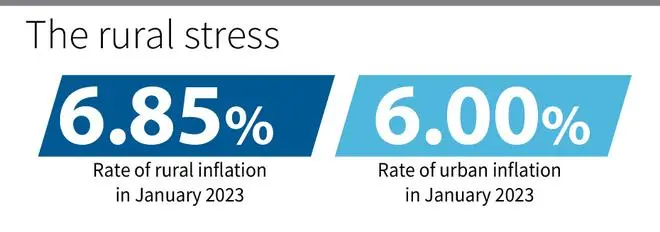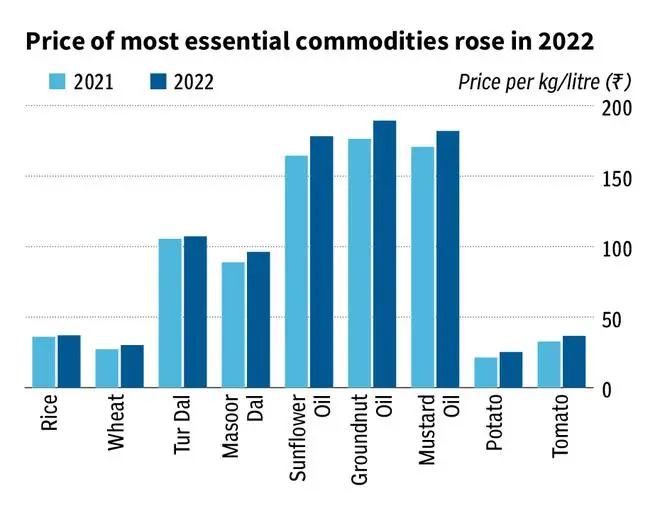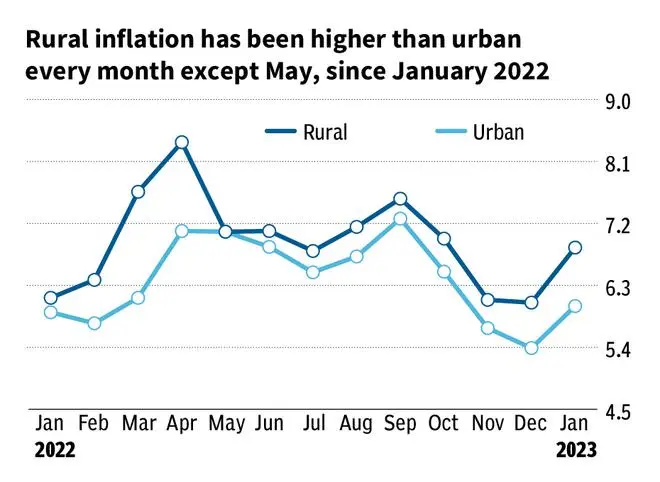Rural CPI inflation in the country has stayed above inflation in urban areas for a year now, from January 2022 to January 2023. While the combined retail inflation in January this year was 6.52 per cent, the rural inflation was 6.85 per cent.

Urban inflation, on the other hand, was 6 per cent. In these 13 months, the difference was the highest in March and April 2022, where rural inflation was 1.54 and 1.29 percentage points higher than urban numbers.
Also read: How will soaring CPI inflation impact RBI, Centre’s actions?
The breakdown of the latest figures shows that the current inflation is driven by high prices of food. Inflation in this component shot up from 4.58 per cent in December to 6.19 per cent in January. Since the food and beverages component of inflation has a higher weight of 54.18 per cent in rural inflation, increase in food prices tends to spike the inflation print for villages.
The weight for food is, on the other hand, quite low at just 36.29 per cent in urban inflation. Housing, which carries a weight of 21.67 per cent in urban areas is not considered while calculating rural inflation.

Purchasing power
Higher purchasing power in rural India due to increasing food prices could also be the reason behind higher rural inflation. According to data shared in the Rajya Sabha by the Ministry of Consumer Affairs, Food and Public Distribution on February 10, 2023, the prices of a lot of essential commodities rose by more than 5 per cent between 2021 and 2022.
Also read: Unlike retail inflation, WPI eases to 4.73% in January
While a kilogram of potato was priced at ₹21.34 per kg in 2021, it rose to ₹25.2 per kg in 2022. The price of rice and wheat has also risen. While the price of the former rose 3 per cent, wheat prices rose almost 11 per cent. The prices of masoor dal and sunflower too increased by 8.40 per cent.

Controlling inflation
Acknowledging the rising rural inflation, in a written reply, Sadhvi Niranjan Jyoti, Minister of State for Consumer Affairs, Food and Public Distribution, said in the Rajya Sabha, “There is no particular trend observed in the inflation rates of the rural and urban sectors over the years. However, in the past year i.e. 2022, it has been observed that rural inflation was greater than urban inflation for 11 months.”
In May 2022 alone, the retail inflation rate was the same in rural and urban areas.

Commenting on measures undertaken by the government to control inflation, she said, “Several supply-side measures have been taken by the Government to address inflation. These include a reduction in excise duty by ₹8 per litre on petrol and ₹6 per litre on diesel on May 21, 2022, prohibition of the export of wheat products, imposition of export duty on rice, reduction in import duties and cess on pulses, maintenance of buffer stock for onion and pulses, rationalisation of tariffs on edible oils, oil seeds, and inputs used in manufactured products.”







Comments
Comments have to be in English, and in full sentences. They cannot be abusive or personal. Please abide by our community guidelines for posting your comments.
We have migrated to a new commenting platform. If you are already a registered user of TheHindu Businessline and logged in, you may continue to engage with our articles. If you do not have an account please register and login to post comments. Users can access their older comments by logging into their accounts on Vuukle.